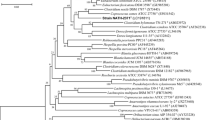Abstract
An intestinal bacterium isolated from a human subject utilized only two methylpentoses (L-rhamnose and L-fucose) and two pentoses (L-lyxose and D-arabinose) as fermentable substrates, among many compounds tested. The isolate was obligately anaerobic and had a distinctive morphology, its cells being rods bent in the shape of rings with the ends slightly overlapping. Single ring-shaped cells and left-handed helical chains of cells were present in cultures. The cells were surrounded by large capsules which appeared as thick, fibrous masses when examined by electron microscopy. Capsules were formed by cells growing in media containing any one of the four fermentable substrates. Terminally located, heat-resistant endospores were formed on plates of an enriched agar medium supplemented with L-rhamnose. End products of L-rhamnose or L-fucose fermentation included acetate, propionate, n-propanol, CO2, and H2. The isolate represented a new species of Clostridium for which the name Clostridium methylpentosum (type strain R2. ATCC 43829) is proposed. This organism may participate in intestinal digestive processes by metabolizing rhamnose released via the enzymatic depolymerization of dietary pectin.
Similar content being viewed by others
Abbreviations
- G+C:
-
guanine plus cytosine
- OD:
-
optical density
- TEM:
-
transmission electron micrograph
References
Bayliss CE, Houston AP (1984) Characterization of plant polysaccharide-and mucin-fermenting anaerobic bacteria from human feces. Appl Environ Microbiol 48:626–632
Carleton O, Charon NW, Allender P, O'Brien S (1979) Helix handedness of Leptospira interrogans as determined by scanning electron microscopy. J Bacteriol 137:1413–1416
Cato EP, George WL, Finegold SM (1986) Clostridium. In: Sneath PHA, Mair NS, Sharpe ME, Holt JG (eds) Bergey's manual of systematic bacteriology, vol 2. Williams & Wilkins, Baltimore MD, pp 1141–1200
Dische Z, Borenfreund E (1949) A specific color reaction of glycolic aldehyde. J Biol Chem 180:1297–1300
Dische Z, Shettles LB (1948) A specific color reaction of methylpentoses and a spectrophotometric micromethod for their determination. J Biol Chem 175:595–603
Doetsch RN (1981) Determinative methods of light microscopy. In: Gerhardt P (ed) Manual of methods for general bacteriology. American Society for Microbiology, Washington DC, pp 21–33
Guirard BM, Snell EE (1981) Biochemical factors in growth. In: Gerhardt P (ed) Manual of methods for general bacteriology. American Society for Microbiology, Washington DC, pp 79–111
Himelbloom BH, Canale-Parola E (1987) Ring-shaped, encapsulated clostridia that ferment only pentoses and methylpentoses. Abstr Annu Meet Am Soc Microbiol I113,p 194
Holdeman LV, Cato EP, Moore WEC (1977) Anaerobe laboratory manual, 4th edn. Virginia Polytechnic Institute and State University, Blacksburg VA
Hungate RE (1969) A roll tube method for cultivation of strict anaerobes. In: Norris JR, Ribbons DW (eds) Methods in microbiology, vol 3B. Academic Press, Inc, New York London, pp 117–132
Jensen NS, Canale-Parola E (1986) Bacteroides pectinophilus sp. nov. and Bacteroides galacturonicus sp. nov.: two pectinolytic bacteria from the human intestinal tract. Appl Environ Microbiol 52:880–887
Kaneuchi C, Miyazato T, Shinjo T, Mitsuoka T (1979) Taxonomic study of helically coiled, sporeforming anaerobes from the intestines of humans and other animals: Clostridium cocleatum sp. nov. and Clostridium spiroforme sp. nov. Int J Syst Bacteriol 29:1–12
Larkin JM, Borrall R (1984) Spirosoma. In: Krieg NR, Holt JG (eds) Bergey's manual of systematic bacteriology, vol 1. Williams & Wilkins, Baltimore MD, pp 126–128
Lowry OH, Rosebrough NJ, Farr AL, Randall RJ (1951) Protein measurement with the Folin phenol reagent. J Biol Chem 193:265–275
Luft JH (1971) Ruthenium red and violet. 1. Chemistry, purification, methods of use for electron microscopy. Anat Rec 171:347–368
Marmur J (1961) A procedure for the isolation of deoxyribonucleic acid from microorganisms. J Mol Biol 3:208–218
Marmur J, Doty P (1962) Determination of the base composition of deoxyribonucleic acid from its thermal denaturation temperature. J Mol Biol 5:109–118
McCarthy RE, Kotarski SF, Salyers AA (1985) Location and characteristics of enzymes involved in the breakdown of polygalacturonic acid by Bacteroides thetaiotaomicron. J Bacteriol 161:493–499
Mortlock RP (1984) The development of catabolic pathways for the uncommon aldopentoses. In: Mortlock RP (ed) Microorganisms as model systems for studying evolution. Plenum Publishing Co, New York, pp 109–134
Nikaido H, Vaara M (1987) Outer membrane. In: Neidhart FC (ed) Escherichia coli and Salmonella typhimurium, cellular and molecular biology. American Society for Microbiology, Washington DC, pp 7–22
Paine CM, Cherniak R (1975) Composition of the capsular polysaccharides of Clostridium perfringens as a basis for their classification by chemotypes. Can J Microbiol 21:181–185
Paster BJ, Canale-Parola E (1982) Physiological diversity of rumen spirochetes. Appl Environ Microbiol 43:686–693
Pfennig N (1978) Rhodocyclus purpureus gen. nov. and sp. nov., a ring-shaped, vitamin B12-requiring member of the family Rhodospirillaceae. Int J Syst Bacteriol 28:283–288
Rexová-Benková L, Marcovič O (1976) Pectic enzymes. Adv Carbohydr Chem Biochem 33:323–385
Salyers AA, Leedle JAZ (1983) Carbohydrate metabolism in the human colon. In: Hentges D (ed) Human intestinal microflora in health and disease. Academic Press, Inc, New York, pp 129–146
Smibert RM, Krieg NR (1981) General characterization. In: Gerhardt P (ed) Manual of methods for general bacteriology. American Society for Microbiology, Washington DC, pp 409–443
Southgate DAT (1976) Determination of blood carbohydrates. Applied Science Publishers Ltd, London, pp 110–111
Weber FH, Canale-Parola E (1984) Pectinolytic enzymes of oral spirochetes from humans. Appl Environ Microbiol 48:61–67
Yoshii Z (1978) Fundamental considerations and experimental conditions on the study of the spiral direction of helical bacteria. Bull Yamaguchi Med Sch 25:115–127
Author information
Authors and Affiliations
Rights and permissions
About this article
Cite this article
Himelbloom, B.H., Canale-Parola, E. Clostridium methylpentosum sp. nov.: a ring-shaped intestinal bacterium that ferments only methylpentoses and pentoses. Arch. Microbiol. 151, 287–293 (1989). https://doi.org/10.1007/BF00406553
Received:
Accepted:
Issue Date:
DOI: https://doi.org/10.1007/BF00406553




